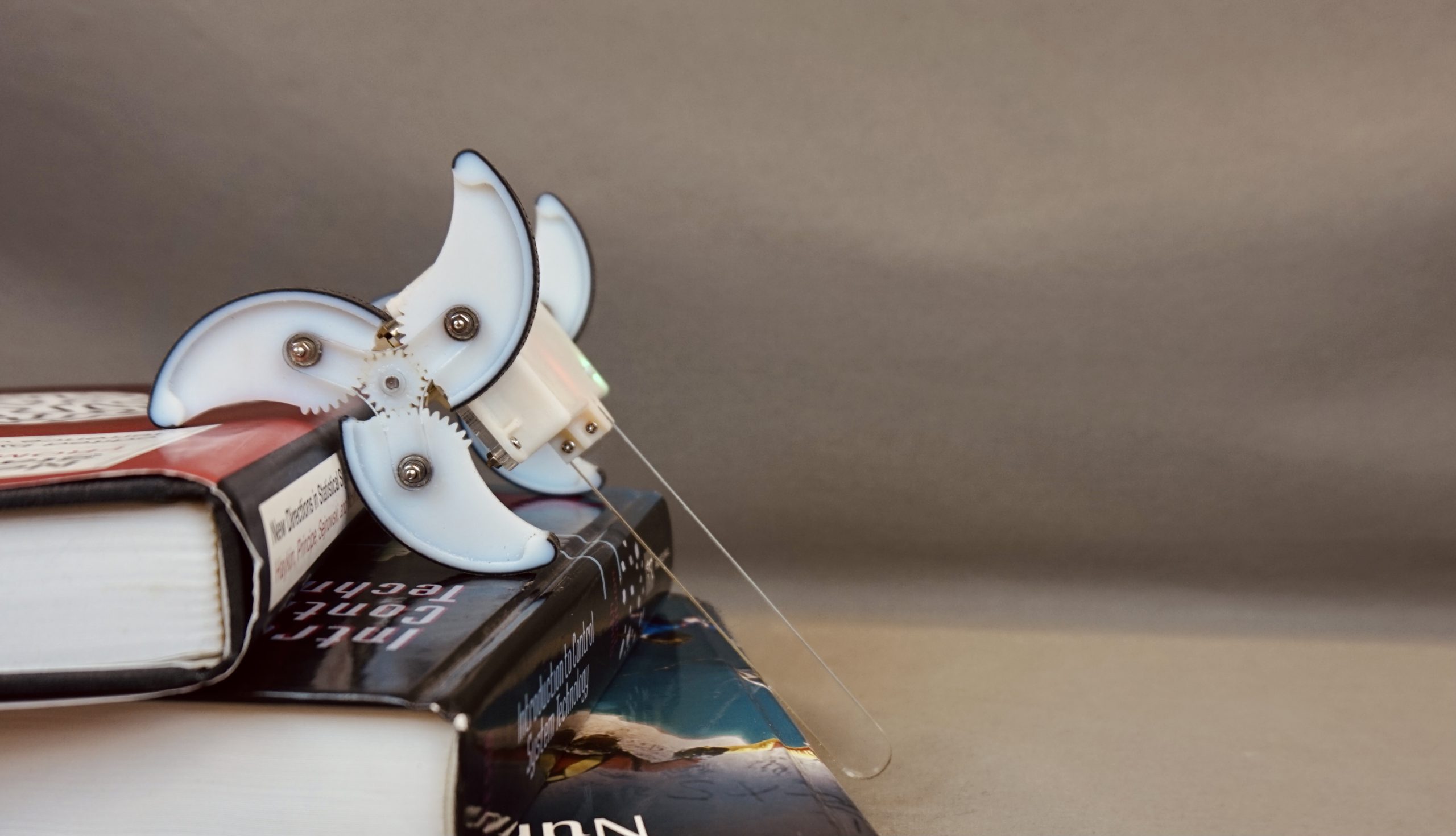Adaptability is a fundamental yet challenging requirement for mobile robot locomotion. This article presents a-WaLTR, a new adaptive wheel-and-leg transformable robot for versatile multiterrain mobility. The robot has four passively transformable wheels, where each wheel consists of a central gear and multiple leg segments with embedded spring suspension for vibration reduction. These wheels enable the robot to traverse various terrains, obstacles, and stairs while retaining the simplicity in primary control and operation principles of conventional wheeled robots. The chassis dimensions and the center of gravity location were determined by a multiobjective design optimization process aimed at minimizing the weight and maximizing the robot’s pitch angle for obstacle climbing. Unity-based simulations guided the selection of the design variables associated with the transformable wheels. Following the design process, α-WaLTR with an embedded sensing and control system was developed. Experiments showed that the spring suspension on the wheels effectively reduced the vibrations when operated in the legged mode and verified that the robot’s versatile locomotion capabilities were highly consistent with the simulations. The system-level integration with an embedded control system was demonstrated via autonomous stair detection, navigation, and climbing capabilities.
Publications
Novel Robotic Mechanisms

WheeLeR: Passive wheel-leg transformable mechanism for mobile robots
Well-designed mechanisms can potentially address many engineering challenges in robotics, by reducing computational and structural complexities for actuation, sensing, and control. We are investigating unconventional robot and mechanism designs for advanced functional and technical capabilities.
Vision-based Ascending Staircase Detection with Interpretable Classification Model for Stair Climbing Robots
Robots capable of traversing flights of stairs play an important role in both indoor and outdoor applications. The capability of accurately identifying a staircase is one of the vital technical functions in these robots. This paper presents a vision-based ascending stair detection algorithm using RGB-Depth (RGB-D) data based on an interpretable model. The method follows the four steps: 1) pre-processing of RGB images for line extraction by applying the dilatation and Canny filters followed by the probabilistic Hough line transform, 2) defining the regions of interests (ROIs) via Kmean clustering, 3) training the initial model based on a support vector machine (SVM) using three extracted features (i.e., gradient, continuity factor, and deviation cost), and 4) building an interpretable model for stair classification by determining the decision boundary conditions. The developed method was evaluated for its performance using our dataset, and the results showed 85% sensitivity and 94% specificity. When the same model was tested on a different test set, the sensitivity and specificity slightly decreased to 80% and 90%, respectively. By shifting the boundary conditions using only a small subset of the new dataset without rebuilding the model, performance was improved to 90% sensitivity and 96% specificity. The presented method is also compared with existing SVM- and neural-network-based methods.
Click here to check the ICRA poster: ICRA2022_Poster_FINAL
Design and analysis of an origami-based three-finger manipulator
This paper describes a new robotic manipulator with three fingers based on an origami twisted tower design. The design specifications, kinematic description, and results from the stiffness and durability tests for the selected origami design are presented. The robotic arm is made of a 10-layer twisted tower, actuated by four cables with pulleys driven by servo motors. Each finger is made of a smaller 11-layer tower and uses a single cable directly attached to a servo motor. The current hardware setup supports vision-based autonomous control and internet-based remote control in real time. For preliminary evaluation of the robot’s object manipulation capabilities, arbitrary objects with varying weights, sizes, and shapes (i.e., a shuttlecock, an egg shell, a paper cub, and a cubic block) were selected and the rate of successful grasping and lifting for each object was measured. In addition, an experiment comparing a rigid gripper and the new origami-based manipulator revealed that the origami structure in the fingers absorbs the excessive force applied to the object through force distribution and structural deformation, demonstrating its potential applications for effective manipulation of fragile objects.
3D-printed semi-soft mechanisms inspired by origami twisted tower
NASA/ESA Conference on Adaptive Hardware and Systems (AHS)
24-27 July 2017
This paper presents a novel modeling and fabrication technique of semi-soft mechanisms inspired by the origami twisted tower. The twisted tower is a modular origami structure consisting of multiple octagon-shaped layers. This structure can generate linear contraction, extension, and bending. A special geometric construct of this design allows each layer to fully collapse by twisting π/4°. Inspired by this unique feature, the design was further diversified to use any regular polygon with m sides, where m ≥ 3 and resulting maximum twisting within a single layer is 2π/m. This design diversification broadens potential applications of this mechanism. Such complex origami designs, however, faces one fundamental problem, i.e. manufacturability. There is no current manufacturing technique available for automating complex sequences of paper folding and assembling. To address this challenge, the twisted tower design was converted into a 3D printable model. 2-layer towers based on a triangle, square, pentagon, hexagon, and octagon were printed using the PolyJet ™ 3D printing technology. For the octagon-based design, an additional 10-layer tower was printed to demonstrate the range of motions preserved from the hand-folded origami tower.
